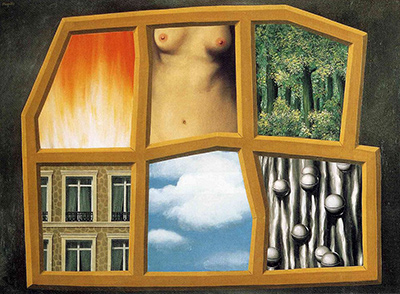The Belgian Painter Rene Magritte created several images of denaturalized frames during the 1928 to 1930 time period. Sometimes they had words in them, planks showcasing the wood’s grain and other times they had nothing at all.
In The Six Elements painting, Magritte has a collection of seemingly unconnected elements in six different frames. This idea can also been seen in his On the Threshold of Liberty painting. The Six Elements was competed in 1928, prior to On the Threshold of Liberty, which was painted one year after the Six Elements. His work with frames showcased poetic eroticism.
There is tension in the six fragments of the image due to the irregularity and fancifulness of the baroque frame. It is seen by many critics as mastery of composition from a purely plastic point of view. Four of the frames can be categorised in the realm of nature: the infernal fire, the luxuriant woods, the breasts of the women and the clouds in the sky.
The frame with the bells symbolizes sound while the fragment image of the building next to the sky helps to keep the entire composition grounded on the earth. For Magritte, a house was not just a place of shelter or means to frame an image. It was the centre of his experience and the dialect between the outside and inside. It represented the infinite and the finite for him.
From his first paintings in 1915 to the surrealist pre-war themes, Magritte wanted to create images that were thought-provoking. He took pleasure in taking objects from people’s everyday life and placing them in scenes and places where the observer’s perception was challenged.
He was at the forefront of the surrealist movement, joining as the head of the movement in 1928 after he moved to Paris. His greatest works included The Menaced Assassin, Elective Affinities, The Son of Man, The Treachery of Images and The Portrait. His work and ideas influenced conceptual and minimalist art.




